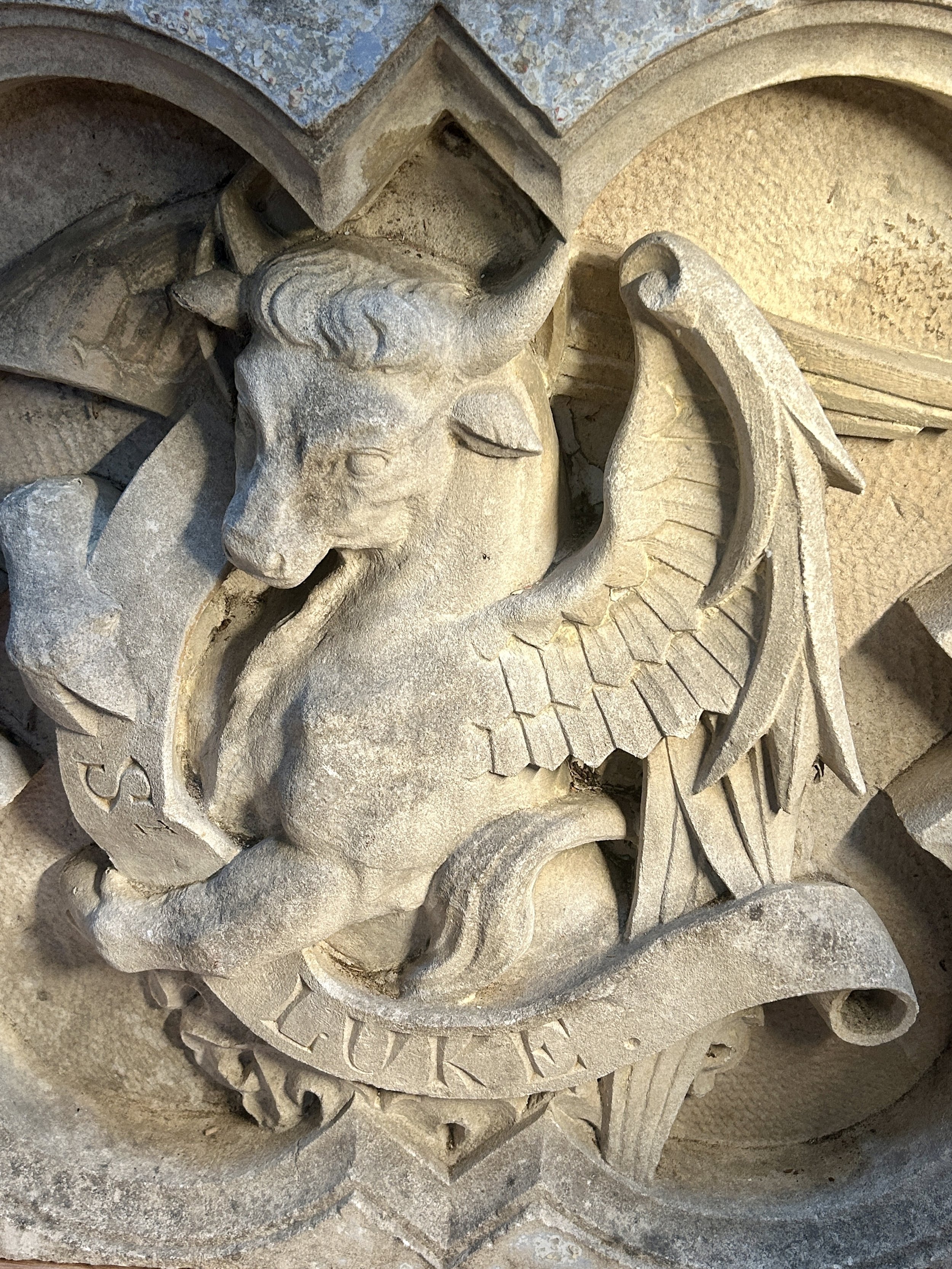 Image 1 of 19
Image 1 of 19

 Image 2 of 19
Image 2 of 19

 Image 3 of 19
Image 3 of 19

 Image 4 of 19
Image 4 of 19

 Image 5 of 19
Image 5 of 19

 Image 6 of 19
Image 6 of 19

 Image 7 of 19
Image 7 of 19

 Image 8 of 19
Image 8 of 19

 Image 9 of 19
Image 9 of 19

 Image 10 of 19
Image 10 of 19

 Image 11 of 19
Image 11 of 19

 Image 12 of 19
Image 12 of 19

 Image 13 of 19
Image 13 of 19

 Image 14 of 19
Image 14 of 19

 Image 15 of 19
Image 15 of 19

 Image 16 of 19
Image 16 of 19

 Image 17 of 19
Image 17 of 19

 Image 18 of 19
Image 18 of 19

 Image 19 of 19
Image 19 of 19




















Pair of 19th Century Carved Bath Stone Church Plaques of St Luke & St John from the Altar of St Barnabas 1843
Impressive pair of 19th Century carved Bath Stone plaques of St Luke and St John from the altar of St Barnabas church and dated to 1843.
Decorative gothic revival style religious antique deep relief sculptures.
St Luke: H: 58.5 x W: 56.5 x D: 13 cm / St John: H: 60.5 x W: 57.5 × D: 12 cm.
The plaques are heavy at approx 80 - 100kg each.
St Luke is in excellent condition. Areas of loss around the bottom corners of St John and some restoration, but the main central sculpture remains complete, and it is structurally solid. They display very well as a architectural pair.
Paperwork provenance confirms the plaques as from St Barnabas Church, Bristol UK - built in 1843 and demolished in 1983, the church also suffered bomb damage during WWII.
In traditional depictions, such as paintings, evangelist portraits, and church sculpture, Saint Luke is often accompanied by an ox or bull, usually having wings. St Luke is suggested by the ox, a sacrificial animal, because his Gospel stresses the sacrificial nature of Christ's ministry.
St John the Evangelist, the author of the fourth gospel account, is symbolised by an eagle, often with a halo, an animal may have originally been seen as the king of the birds. The eagle is a figure of the sky, and believed by Christian scholars to be able to look straight into the sun. It appears with the other three beings as the tetramorph, interpreted in Christianity as symbols of the evangelists. The four beings appear as the living creatures in the Bible.
Bath Stone is an oolitic limestone comprising granular fragments. Its honey colouring gives the World Heritage City of Bath its distinctive appearance, and it has been used extensively as a building material throughout southern England, for churches, houses, and public buildings.
Impressive pair of 19th Century carved Bath Stone plaques of St Luke and St John from the altar of St Barnabas church and dated to 1843.
Decorative gothic revival style religious antique deep relief sculptures.
St Luke: H: 58.5 x W: 56.5 x D: 13 cm / St John: H: 60.5 x W: 57.5 × D: 12 cm.
The plaques are heavy at approx 80 - 100kg each.
St Luke is in excellent condition. Areas of loss around the bottom corners of St John and some restoration, but the main central sculpture remains complete, and it is structurally solid. They display very well as a architectural pair.
Paperwork provenance confirms the plaques as from St Barnabas Church, Bristol UK - built in 1843 and demolished in 1983, the church also suffered bomb damage during WWII.
In traditional depictions, such as paintings, evangelist portraits, and church sculpture, Saint Luke is often accompanied by an ox or bull, usually having wings. St Luke is suggested by the ox, a sacrificial animal, because his Gospel stresses the sacrificial nature of Christ's ministry.
St John the Evangelist, the author of the fourth gospel account, is symbolised by an eagle, often with a halo, an animal may have originally been seen as the king of the birds. The eagle is a figure of the sky, and believed by Christian scholars to be able to look straight into the sun. It appears with the other three beings as the tetramorph, interpreted in Christianity as symbols of the evangelists. The four beings appear as the living creatures in the Bible.
Bath Stone is an oolitic limestone comprising granular fragments. Its honey colouring gives the World Heritage City of Bath its distinctive appearance, and it has been used extensively as a building material throughout southern England, for churches, houses, and public buildings.
SHIPPING:
Purchase price does not include shipping. All items are shipped fully insured from our London SE18 address. Or collection is possible most days by appointment.
This item is for UK or West & Central European delivery with van courier only.
Courier delivery to London: £50 / South East England £70 / Rest of England & Wales £100 / Scotland £120 / West & Central Europe Est. £250 + input duties/VAT & customs agent fee (message for details)